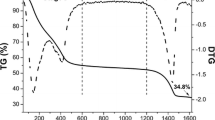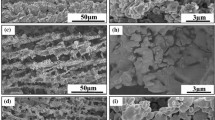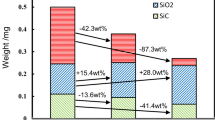Abstract
In this work, the preparation of foam-gelcasting was simplified with a copolymer of isobutylene and maleic anhydride (Isobam), avoiding the traditional gelling system including many additives such as monomer, cross-linking agent, initiator and catalyst. Highly porous yttria-stabilized zirconia (YSZ) ceramics with 76.2–84.9% porosity were prepared via foam-gelcasting method using YSZ powder as the raw material, Isobam as the dispersant and gelling agent, triethanolamine lauryl sulfate as the foaming agent and sodium carboxymethyl cellulose as the foam stabilizing agent. The effects of solid loading, the content of foaming agent as well as sintering temperature were investigated. With the increase in solid loading of slurries, lower porosity was obtained, and the compressive strength and thermal conductivity showed a tendency of increase. Porous YSZ ceramics with compressive strength of 0.69–3.66 MPa showed low thermal conductivity in the range of 0.137–0.254 W/(m·K) at room temperature. The as-prepared sample showed good thermal insulating performance at high temperature. The km in GM model was during 0.4–0.7, which indicated the pore structure containing the internal and external porosities. This work provides a facile method for the fabrication of porous YSZ ceramics which can be potentially applied as thermal insulation materials at high temperature.











Similar content being viewed by others
Change history
03 January 2022
A Correction to this paper has been published: https://doi.org/10.1007/s10853-021-06745-w
References
Scheffler M, Colombo P (2006) Cellular ceramics: structure, manufacturing, properties and applications. Wiley, Weinheim
Colombo P (2006) Conventional and novel processing methods for cellular ceramics. Philos Trans A Math Phys Eng Sci 364:109–124
Trueba M, Trasatti SP (2005) γ-Alumina as a support for catalysts: a review of fundamental aspects. Eur J Inorg Chem 17:3393–3403
Faure R, Rossignol F, Chartier T, Bonhomme C, Maître A, Etchegoyen G, Del Gallo P, Gary D (2011) Alumina foam catalyst supports for industrial steam reforming processes. J Eur Ceram Soc 31:303–312
Yuan K, Jin X, Yu Z, Gan X, Wang X, Zhang G, Zhu L, Xu D (2017) Electrospun mesoporous zirconia ceramic fibers for catalyst supporting applications. Ceram Int 44:282–289
Nait-Ali B, Haberko K, Vesteghem H, Absi J, Smith DS (2006) Thermal conductivity of highly porous zirconia. J Eur Ceram Soc 26:3567–3574
Zhu XW, Jiang DL, Tan SH (2002) Preparation of silicon carbide reticulated porous ceramics. Mater Sci Eng A 323:232–238
She JH, Deng ZY, Daniel-Doni J, Ohji T (2002) Oxidation bonding of porous silicon carbide ceramics. J Mater Sci 37:3615–3622. https://doi.org/10.1023/A:1016596805717
Huo WL, Zhang XY, Chen YG, Hu ZL, Wang D, Yang JL (2019) Ultralight and high-strength bulk alumina/zirconia composite ceramic foams through direct foaming method. Ceram Int 45:1464–1467
Hu LF, Wang CA, Hu ZJ, Lu S, Sun CC, Huang Y (2011) Porous yttria-stabilized zirconia ceramics with ultra-low thermal conductivity. part II: temperature dependence of thermophysical properties. J. Mater. Sci. 46:623–628. https://doi.org/10.1007/s10853-010-4783-y
Li S, Wang CA, Hu LF (2013) Improved heat insulation and mechanical properties of highly porous YSZ ceramics after silica aerogels impregnation. J Am Ceram Soc 96:3223–3227
Huo WL, Zhang XY, Chen YG, Wang D, Liu JJ, Yan S, Yang JL (2018) Mechanical strength of highly porous ceramic foams with thin and lamellate cell wall from particle-stabilized foams. Ceram Int 44:5780–5784
Díaz A, Hampshire S (2004) Characterisation of porous silicon nitride materials produced with starch. J Eur Ceram Soc 24:413–419
Vakifahmetoglu C, Menapace I, Hirsch A, Biasetto L, Hauser R, Riedel R, Colombo P (2009) Highly porous macro- and micro-cellular ceramics from a polysilazane precursor. Ceram Int 35:3281–3290
Dhara S, Bhargava P (2003) A simple direct casting route to ceramic foams. J Am Ceram Soc 50:1645–1650
Zhang LY, Zhou DL, Chen Y, Liang B, Zhou JB (2014) Preparation of high open porosity ceramic foams via direct foaming molded and dried at room temperature. J Eur Ceram Soc 34:2443–2452
Preiss A, Su B, Collins S, Simpson D (2012) Tailored graded pore structure in zirconia toughened alumina ceramics using double-side cooling freeze casting. J Eur Ceram Soc 32:1575–1583
Lee JH, Choi HJ, Yoon SY, Kim BK, Park HC (2013) Porous mullite ceramics derived from coal fly ash using a freeze-gel casting/polymer sponge technique. J Porous Mater 20:219–226
Zhou J, Wang CA (2013) Porous yttria-stabilized zirconia ceramics fabricated by nonaqueous-based gelcasting process with PMMA microsphere as pore-forming agent. J Am Ceram Soc 96:266–271
Hu LF, Wang CA, Huang Y (2010) Porous yttria-stabilized zirconia ceramics with ultra-low thermal conductivity. J Mater Sci 45:3242–3246. https://doi.org/10.1007/s10853-010-4331-9
Li CW, Deng NN, Wu LH, Li H, Wang CA (2017) Fabrication of porous ZrO2 ceramics with tailorable pore structure by foam-gelcasting. J Chin Ceram Soc 47:1–8
Han Y, Li C, Bian C, Li S, Wang CA (2013) Porous anorthite ceramics with ultra-low thermal conductivity. J Eur Ceram Soc 33:2573–2578
Wu H, Li Y, Yan Y, Yin J, Liu X, Huang Z, Lee SH, Jiang D (2014) Processing, microstructures and mechanical properties of aqueous gelcasted and solid-state-sintered porous SiC ceramics. J Eur Ceram Soc 34:3469–3478
Potoczek M (2008) Gelcasting of alumina foams using agarose solutions. Ceram Int 34:661–667
Yang Y, Shimai S, Wang S (2013) Room-temperature gelcasting of alumina with a water-soluble copolymer. J Mater Res 28:1512–1516
Lu YJ, Gan K, Huo WL, Lv L, Liu JJ, Zhang XY, Yan S, Yang JL (2018) Dispersion and gelation behavior of alumina suspensions with Isobam. Ceram Int 44:11357–11363
Han L, Li FL, Deng XG (2017) Foam-gelcasting preparation, microstructure and thermal insulation performance of porous diatomite ceramics with hierarchical pore structures. J Eur Ceram Soc 37:2717–2725
Deng XG, Wang JK, Liu JH (2015) Preparation and characterization of porous mullite ceramics via foam-gelcasting. Ceram Int 41:9009–9017
Wan T, Yao DX, Hu HL (2014) Fabrication of porous Si3N4 ceramics through a novel gelcasting method. Mater Lett 133:190–192
Huo WL, Zhang XY, Gan K (2019) Effect of zeta potential on properties of foamed colloidal suspension. J Eur Ceram Soc 39:574–583
Zhang SY, Lan Q, Liu Q, Xu J, Sun DJ (2008) Aqueous foams stabilized by laponite and CTAB. Colloids Surf A: Physicochem Eng Aspects 317:406–413
Hu LF, Wang CA, Sun CC (2010) Fabrication and properties of porous yttria-stabilized zirconia ceramics. Aero Mater Tech 40:55–58
Huo WL, Zhang XY, Chen YG (2016) Highly porous zirconia ceramic foams with low thermal conductivity from particle-stabilized foams. J Am Ceram Soc 99:3512–3515
Leach AG (1993) The thermal conductivity of foams: i. Models for heat conduction. J. Phys. D: Appl. Phys. 26:733–739
Gong LL, Wang YH, Cheng XD, Zhang RF, Zhang HP (2014) A novel effective medium theory for modelling the thermal conductivity of porous materials. Int J Heat Mass Tran 68:295–298
Funding
This work was supported by the Basic Research Program of Shenzhen (No. JCYJ20170306155944271), the National Natural Science Foundation of China (Nos. 51672219, 51702259), the China-Poland International Collaboration Fund of National Natural Science Foundation of China (No. 51961135301) and the Fundamental Research Funds for the Central Universities (Nos. 3102019GHJD001, 3102019MS0406). We would like to thank the Analytical & Testing Center of Northwestern Polytechnical University for the XRD, SEM, and other analyses.
Author information
Authors and Affiliations
Corresponding author
Ethics declarations
Conflict of interest
The authors declare that they have no conflict of interest.
Additional information
Publisher's Note
Springer Nature remains neutral with regard to jurisdictional claims in published maps and institutional affiliations.
Rights and permissions
About this article
Cite this article
Meng, X., Xu, J., Zhu, J. et al. Porous yttria-stabilized zirconia ceramics with low thermal conductivity via a novel foam-gelcasting method. J Mater Sci 55, 15106–15116 (2020). https://doi.org/10.1007/s10853-020-04900-3
Received:
Accepted:
Published:
Issue Date:
DOI: https://doi.org/10.1007/s10853-020-04900-3




